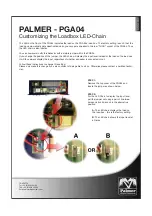
10
•
Keep tool and cutting blades clean
-
clean the tool with a damp cloth (do not use cleaning
agents or solvents)
-
after use, always carefully clean and lightly lubricate the
cutting blades
! wear gloves when handling or cleaning the cutting
blades
•
Regularly check the condition of the cutting blades and
the tightness of the blade bolts
•
Regularly check for worn or damaged components and
have them repaired/replaced when necessary
•
Sharpening the cutting blades
-
remove cutting blades from tool before sharpening
-
sharpen the cutting blades with a small and smooth file,
in case a solid object damaged them
-
we advise you, however, to have the blades sharpened
by a specialist
-
lubricate the cutting blades after sharpening
•
Storage
i
-
store the tool indoors in a dry and locked-up place, out
of reach of children
-
securely mount storage rail on the wall with 2 screws
(not supplied) and horizontally leveled
-
use blade covers when storing the tool
-
lubricate the cutting blades before storing the tool
TROUBLESHOOTING
•
The following listing shows problem symptoms, possible
causes and corrective actions (if these do not identify
and correct the problem, contact your dealer or service
station)
Tool operates intermittently
-
internal wiring defective -> contact dealer/service
station
-
on/off switch defective -> contact dealer/service station
Motor runs but blades remain stationary
-
internal fault -> contact dealer/service station
Cutting blades hot
-
cutting blades blunt -> have blades sharpened
-
cutting blades have dents -> have blades inspected
-
too much friction due to lack of lubricant -> lubricate
blades
ENVIRONMENT
• Do not dispose of electric tools, batteries,
accessories and packaging together with household
waste material.
The electric tools, batteries, accessories
and packaging should be sorted for environmental-
friendly recycling
! Prior to disposal protect battery terminals with
heavy tape to prevent short-circuit






























